|
Antique Solid mahogany writing box in typical late 18th century style c1790
It is very like Jane Austin's writing box
Please click on images to enlarge | slide show | thumbnail
index |
Reference: WB469
Description:
WB469: Solid mahogany writing box in typical late 18th century style c1790
This is a solid mahogany writing box made in the characteristic late 18th century style, designed to withstand military campaigns and/or extensive travelling.
There are drop down handles on the two sides; these in the early form of handles. There is a side drawer which pulls out when a brass pin is pulled out when the box is in the open position. There are T hinges and brass strengtheners in the corners. There is also a reading stand which is attached to the top surface when the box is held at an angle with the hinged brass catch. The surface under the top flap is in oak.
There is an old baize covering on the writing surface which is the correct lining for such a box. However this is not the original, but a later, albeit now old repair.
Working lock and key.
Origin: UK
Circa: 1790
Materials: mahogany
and oak
Size: 45 cm by 24.2 cm by 16.5 cm: 17.7 inches by 9.5 inches by
6.5 inches.
Condition:
Thin crack on top (slight opening of original joint). Shallow scratches stains etc in keeping with the life story of the box.
|
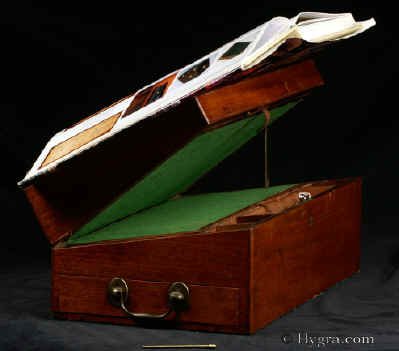
This box is very similar to that which was owned and used by Jane
Austin.

Jane Austen's Writing Box |

In 1798 Jane and her writing box were briefly separated. Her letter written from the "Bull and George in Deptford to her sister Cassandra gives a good idea as to how important the writing box was to her.
|
There is inlaid version of the 18th century box illustrated at:
Hygra: Antique late 18th century inlaid mahogany writing box with an unusual secret compartment
And another version with brass edging at: Hygra: Antique writing box Circa 1790
|
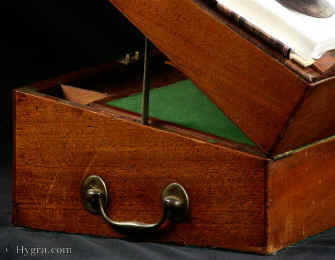
|
There is also a reading stand which is attached to the top surface when the box is held at an angle with the hinged brass catch.
The reading stand was very
useful in a time when light was either from window or candle. A book
could be arranged to maximize the available light.
The box enabled you to read
and gather knowledge for longer.
Perhaps it inspired you to
open it and start writing.
|
Please click on images to enlarge | slide show | thumbnail
index |
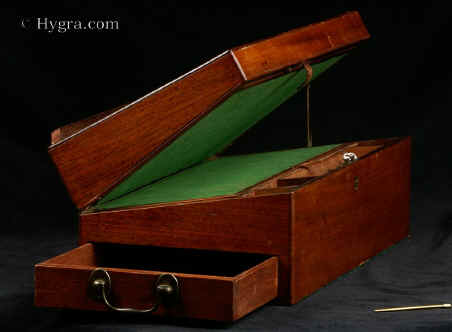
|
The pen tray is of the curved
form. Sometimes earlier and later there was a tray. A
tray could hold more pens, but could become cluttered.
The curved form which could
be lifted out would at best hold just a few writing implements.
|
| This is a picture of Jane Austin's box which is now in
the British Library. .
|
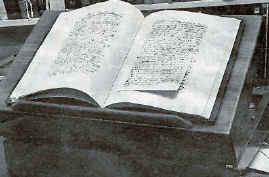
|
Please click on images to enlarge| slide show | thumbnail
index |
| The box is opened |
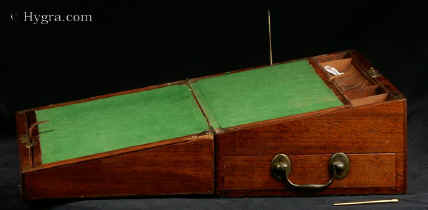
|
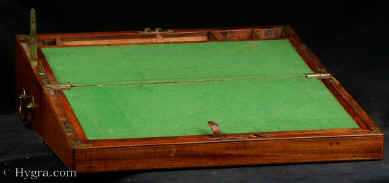
|
and you face it. There is a comfortable surface on
which to write. |
Please click on images to enlarge
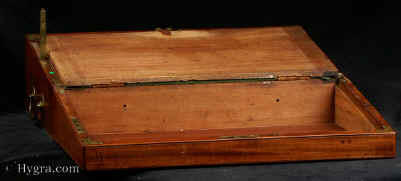
|
You have left papers of the current writing activity under
the flap.
The two holes to hold the reading stand, when not in us, are
visible.
|
| And there is more room for the other project under the
other flap. |
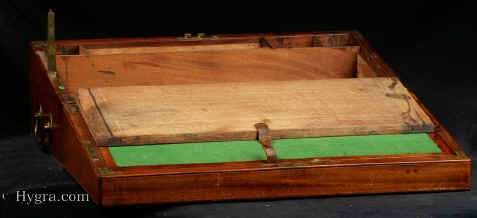
|
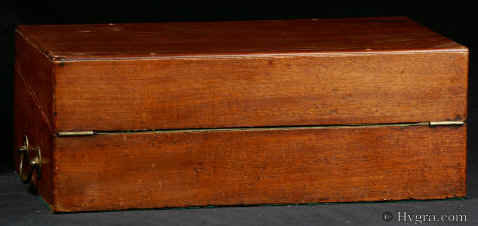
|
Detail: the box fully closed the back
|
Please click on images to enlarge| slide show
| thumbnail
index |
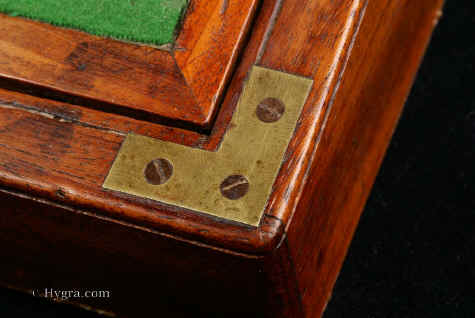
Extract: Choosing and Making the right
joints by Tage Frid.
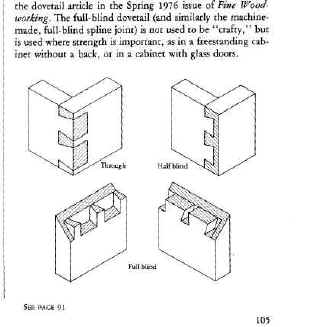
This image is courtesy of Fine Woodworking Techniques 1978
Taunton Press inc. ISBN: 0918804027
You can
order the Fine Woodworking Techniques from Amazon by clicking one of the links below:
|
A corner.
In the sides of the box,
the carpentry is clear. This is a double blind sometimes called a
"full blind" dovetail joint.
The joint is strengthened with a
piece of brass. These are sometimes cast and sometimes cut from sheet.
At this date the holding screws, as here, are mostly iron or steel and turned to a
screw which would hold itself. A hole would first have to be drilled.
The surface would then be flattened. These screws look as if they have
never moved since they were put in.
It is not easy to move these
screws whose slots are almost never in the center and have ground to be flat with
the brass.
The joint is visually very different
to a simple miter. A miter joint which glues end grain
wood to end grain wood is much weaker and would not have survived the rigors
of travel or 200 years.
Dovetail joints:
The dovetail joint is one of the
wonders of woodwork. In the full blind none of the careful work is
visible. If the joint is simply mitered it will not survive
atmospheric change. A mitered joint is end grain to end grain. The
glue soaks in, becomes dry and brittle and falls apart.
The dovetail joint enables side
grain to be glued to side grain. These joints would hold together
without glue!
It is the true proof of these
dovetail joints made by craftsmen 200 years ago that their joints are
as they made them.
This image is courtesy
of Fine Woodworking Techniques 1978 Taunton Press inc. ISBN:
0918804027
|
Some earlier user of the box has added a strip of leather to
make opening the flap easier.
|
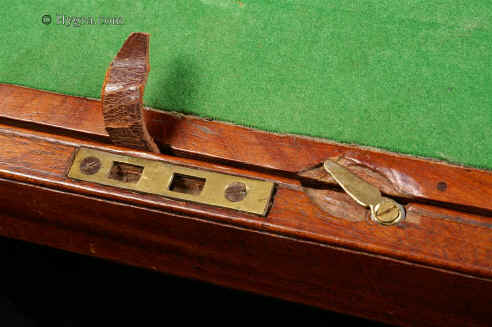
|
Detail of the slotted brass inlaid into the facing which
enables the angle of the reading stand to be adjusted.
|
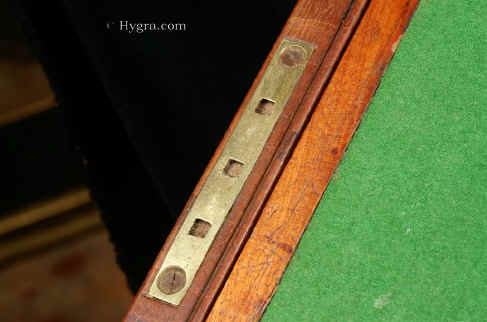
|
Please click on images to enlarge| slide show | thumbnail
index |
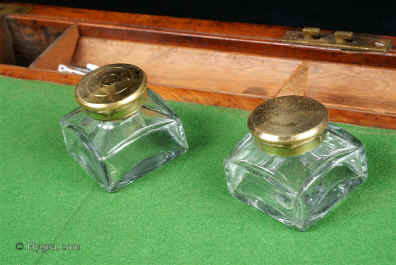
|
The box has two replacement screw top inkwells. Although these are of
new manufacture they are similar to those that would have been used by
18th and 19th Century users of the box.
|
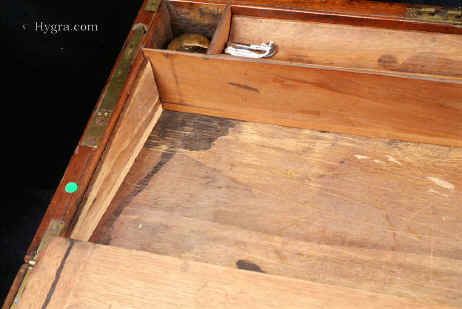
|
Much of the inside construction wood is oak. |
Please click on images to enlarge| slide show | thumbnail
index |
| The box has a side drawer of dovetail construction for
storing additional papers. |
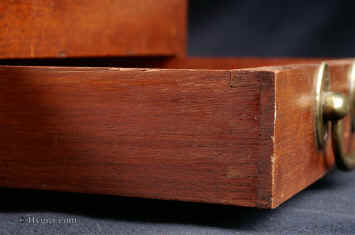
|
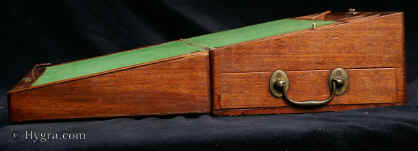
|
The side handles are external and not countersunk as in later
boxes.
|
Please click on images to enlarge| slide show
| thumbnail
index |
Under the writing surfaces there are places for storing papers.
The reading stand when not in use is also stored here.
|
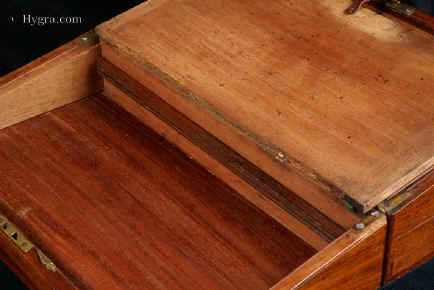
|
In the main wood of the box,
the carpentry is clear. This is a double blind sometimes called a
"full blind" dovetail joint.
The joint is strengthened with a
piece of brass. These are sometimes cast and sometimes cut from sheet.
At this date the holding screws are mostly iron or steel and turned to a
screw which would hold itself. A hole would first have to be drilled.
The surface would then be flattened. These screws look as if they have
never moved since they were put in.
|
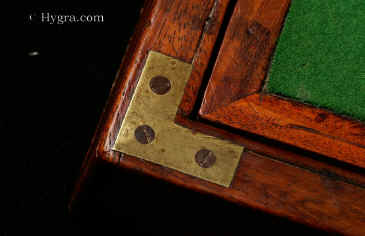
|
Please click on images to enlarge| slide show | thumbnail
index |
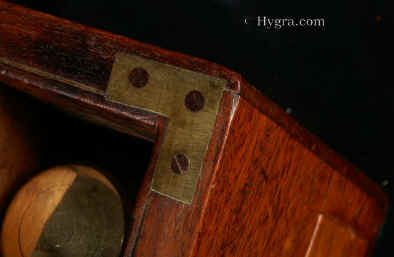
|
In the main wood of the box,
the carpentry is clear. This is a double blind sometimes called a
"full blind" dovetail joint.
It is strengthened with a
piece of brass. These are sometimes cast and sometimes cut from sheet.
At this date the holding screws are mostly iron or steel and turned to a
screw which would hold itself. A hole would first have to be drilled.
The surface would then be flattened. These screws look as if they have
never moved since they were put in.
|
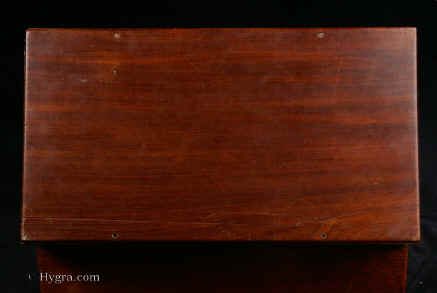
|
The top of the box is in fact made of two pieces of
wood. The join is just visible. The cabinet maker must not have had a
piece of quartered mahogany wide enough.
Quartered mahogany with a straight grain is used to avoid warping.
It is interesting that there is a similar join visible in Jane Austen's
box which is now in the British Library.
|
Please click on images to enlarge| slide show
| thumbnail
index |
Please click on images to enlarge| slide show
| thumbnail
index |
Please click on images to enlarge| slide show
| thumbnail
index |

Jane Austen's Writing Box
|

In 1798 Jane and her writing box were briefly separated. Her letter written from the "Bull and George in Deptford to her sister Cassandra gives a good idea as to how important the writing box was to her.
|
Request
current list of available writing boxes.
News
| Buying
| email | Online
History of boxes | The
Schiffer Book |
All text and images and linked images are ©
1999-2009 Antigone Clarke and Joseph O'Kelly. If you require any further
information on permitted use, or a licence to republish any material, email us
at copyright@hygra.com
| 